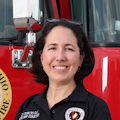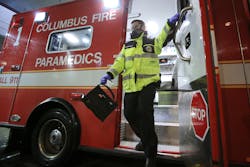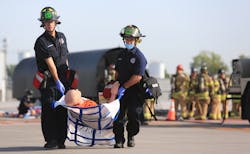In February 2020, two firefighters died after running out of air during a search in a library. The National Institute for Occupational Safety and Health report listed not only tactical inefficiencies as contributing factors but also lack of crew integrity, communication difficulties, and ineffective mayday procedures and survival techniques. Some key recommendations from the investigation included ensuring that firefighters are trained in situational awareness, radio discipline and proper use, and maintaining crew integrity, in addition to multiple recommendations that focused on tactical and operational procedures and training.
This is only one recent example in which human error contributed to the loss of firefighters in the line of duty.
CRM’s five guiding principles
It’s estimated that the firefighter community in the United States loses approximately 80–100 firefighters per year to line-of-duty deaths. Half of those deaths are medical. The other half result from a motor vehicle crash, rapid fire progression, a struck-by event, a structural collapse, lost/disorientation or a fall in which human error had at least a minor role.
- Janine Curcio will present “Preventing and Managing Human Error Using Crew Resource Management" and "Documentation Pearls and Pitfalls: Protecting Yourself on High-Risk Runs” at Firehouse Expo 2023.
CRM is built on five guiding principles:
- Situational awareness: the degree of accuracy by which one’s perception of the current environment mirrors reality
- Decision-making: the ability to choose a course of action that uses logical and sound judgment that’s based on available information
- Workload/task management: a system that’s used by effective leaders to delegate or divide tasks among a team, so no team member becomes oversaturated
- Teamwork: work done by several associates, with each doing a part but all subordinating personal prominence to the efficiency of the whole
- Communication: the successful conveying or sharing of ideas and feelings
At the crux of these principles are advocacy and inquiry communication, or the ability for members of a team to “say something” when they “see something” or when they believe that the plan is flawed.
These principles stem from the common deficiencies that human error derives from lackings in communication, knowledge, teamwork, resources and assertiveness—in addition to complacency, distraction, pressure, stress and accepted norms.
It’s important to note that CRM isn’t a safety program. It teaches behavior modification; safety is the byproduct.
Also important to note: CRM isn’t Just Culture, but they do go hand in hand. Whereas Just Culture is a form of preventing future error by creating a culture that focuses on improvement and patient safety by nonpunitive inquiry and investigation after a near miss or incident occurred, CRM applies principles to the scene or active environment to prevent the error in the first place.
Awareness, reinforcement, refresh
After the concept of CRM was proven in the aviation community in the form of significant accident reduction, other communities that have similar rank structure and complex environments, including medicine and emergency medical services, started to adopt its principles. After all, human error can creep into everyday operations, and not only can it cause harm to providers, but it can do the same to patients, too.
In the past 20 years, there has been an increased push to include CRM in the fire service, but how do we continue to translate that into EMS?
The first step is building an organizational culture in which CRM can thrive. This culture respects each person and realizes that each member provides value to the team and mission. It respects open and honest communication up and down the chain of command. It understands that errors happen and are learning experiences. It’s important to realize that CRM is only the framework of a behavioral modification building that’s built on the foundation of organizational culture. If the culture breeds fear and intimidation, CRM can’t and won’t thrive.The second step toward the succesful translation of CRM into EMS is training through awareness, reinforcement and refresh
Initial training is the awareness piece. It’s an introduction to and overview of CRM, including the history, the principles, the barriers that can affect good CRM and the methods to overcome those barriers. It also discusses advocacy and inquiry communication.
It’s important in the initial training to have exercises in place to practice communication strategies, advocacy and inquiry communication. This starts to build the foundation of open and honest communication before the stress of a medical simulation is added. It provides a script to those who might be more hesitant to speak up.
Reinforcement is simulation that focuses not only on the correct medical management of the patient but also the CRM principles. You can turn any medical scenario into a CRM simulation by specifically debriefing each principle, but sometimes writing a scenario around a principle is more effective. For example, a situational awareness simulation could be with dim lighting or a difficult airway scenario in which the patient desaturates quickly. Did the provider lose situational awareness of the patient status and become fixated on obtaining the airway?
For teamwork, develop a scenario in which one of the team members is more overbearing and distracting from the team lead. Have someone give the wrong suggestion for medical management and see whether other team members speak up, a classical simulation that focuses on inquiry communication.
When I was in the aviation community, we debriefed CRM in a training scenario at least monthly. It was an important point, and it always was discussed. Adding at least a roundtable discussion about CRM in regular run reviews, in addition to simulation scenarios, can help to keep the principles fresh in a provider’s mind, which allows the concepts to continue to perpetuate the culture of open and honest communication.
Refresh is a sit-down session that defines CRM and its principles with role-playing without the stress of a medical scenario. Normally in aviation, the refresh would be a yearly in-service training that brought everyone back to the classroom. At your agency, this might be an initial training followed by monthly reinforcement scenarios and an in-service training a year later.
As you get new recruits or providers, fold initial CRM training into their onboarding process, so they can be active participants in the monthly scenarios.
It’s advantageous to schedule the yearly refresh for the same time every year.
First step: culture review
Introducing CRM concept into your EMS operations can seem like a daunting task, but like other programs, the most difficult part is taking that first step to initiate it.
First, honestly review your organizational culture. Is it a culture in which CRM can thrive? If not, make the appropriate adjustments by setting organizational expectations and leadership examples.
Second, implement initial training and add CRM discussions and simulation to your already established monthly training.
Finally, check in yearly with CRM in-service training and make appropriate adjustments that are based on feedback from providers and leadership.
About the Author

Janine Curcio
Janine E. Curcio, D.O., is a board-certified emergency medicine and emergency medical services physician. Curcio attended the U.S. Naval Academy and served in the U.S. Navy as a P-3 naval flight officer. Curcio attended medical school at Lake Erie College of Osteopathic Medicine. She completed her residency and fellowship at the OhioHealth Doctors Hospital. Curcio works clinically at OhioHealth Grady Memorial Hospital in addition to her time with Columbus, OH, Division of Fire.
Sign up for our eNewsletters
Get the latest news and updates


